Architectural Developments
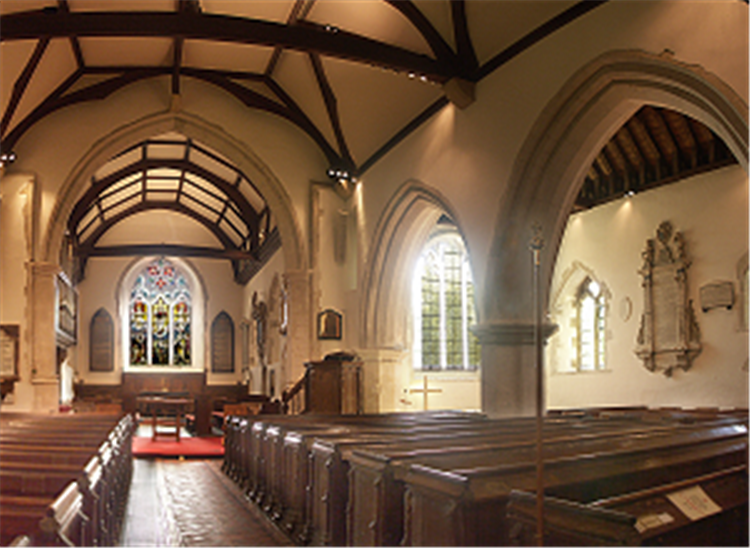
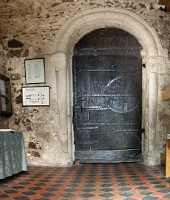 There appears to be no standing fabric from before the Norman conquest. However, the Nave of the late 11th or early 12th century church partly survives. The north and west walls still stand with, within the west wall, the famous moulded stone doorway and door circa 1115AD. The western door is justly famous. The edges are defined by carved pillars on bases and cushion capitals with a roll moulding around the arch. The arch also contains its original complete plank door with its ironwork. Unfortunately, the top of the door was cut off in the 17th century but remains as a fixed tympanum.
There appears to be no standing fabric from before the Norman conquest. However, the Nave of the late 11th or early 12th century church partly survives. The north and west walls still stand with, within the west wall, the famous moulded stone doorway and door circa 1115AD. The western door is justly famous. The edges are defined by carved pillars on bases and cushion capitals with a roll moulding around the arch. The arch also contains its original complete plank door with its ironwork. Unfortunately, the top of the door was cut off in the 17th century but remains as a fixed tympanum.
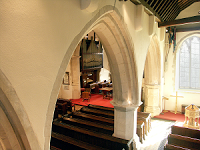 Only the lower section of the Tower with its clasping buttresses dates from 1200 to 1220. The Chancel, which is large by comparison with the Nave, also dates to the first quarter of the century and retains four original lancet windows. A 13th century piscina also survives.
Only the lower section of the Tower with its clasping buttresses dates from 1200 to 1220. The Chancel, which is large by comparison with the Nave, also dates to the first quarter of the century and retains four original lancet windows. A 13th century piscina also survives.
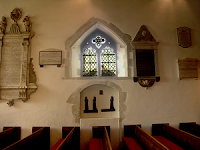 The 14th century saw further significant alterations to the building. In the Chancel the existing eastern window of circa 1320 to 1350 was added. The original tracery survives although repaired, however, the mullions are modern. The 14th century also saw windows added and altered in the north wall of the Nave.
The 14th century saw further significant alterations to the building. In the Chancel the existing eastern window of circa 1320 to 1350 was added. The original tracery survives although repaired, however, the mullions are modern. The 14th century also saw windows added and altered in the north wall of the Nave.
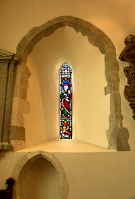
The late 14th and early 15th centuries saw the addition of the South Aisle. The three large octagonal arcade pillars, constructed of chalk, are dated 1420 with their original capitals. The piscina in the Aisle is reputed to be circa 1460. In the 15th century the upper sections of the Western Tower were added between 1460 and 1470.
There is 19th century reference to a Norman doorway in the South Aisle but no evidence exists today. The majority of the windows in the north wall of the Nave are said to be circa 1540. The brick South Porch appears on a map of Woking from 1607. This unusual structure has a crows feet gable and was probably also built in the late 16th century.
In 1620 Sir Edward Zouche was given Woking Palace by James I. It was he who added the western gallery in 1622 with the Royal Arms. To celebrate its 400th anniversary an interesting history of the gallery has been put together by Dr Anthony Morton.
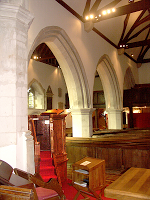 St Peter’s Church has clearly had a series of 19th century restorations with the addition of the northern Vestry block (later extended) in the 19th century perhaps in 1886.
St Peter’s Church has clearly had a series of 19th century restorations with the addition of the northern Vestry block (later extended) in the 19th century perhaps in 1886.
The pews and internal arrangements seem to date from a restoration carried out between 1839 and 1840 to designs by the surveyor John Lawrence. Copies of the drawings showing the revised arrangement are held by the ICBS.
In 1962 the Clergy and Choir Vestry had a first floor added to provide additional accommodation. The new staircase to the towers floor was added.
Recently the church has had a new LED lighting system. There is a Hearing Aid Loop system in place.
Find out more about Fixtures and Fittings.